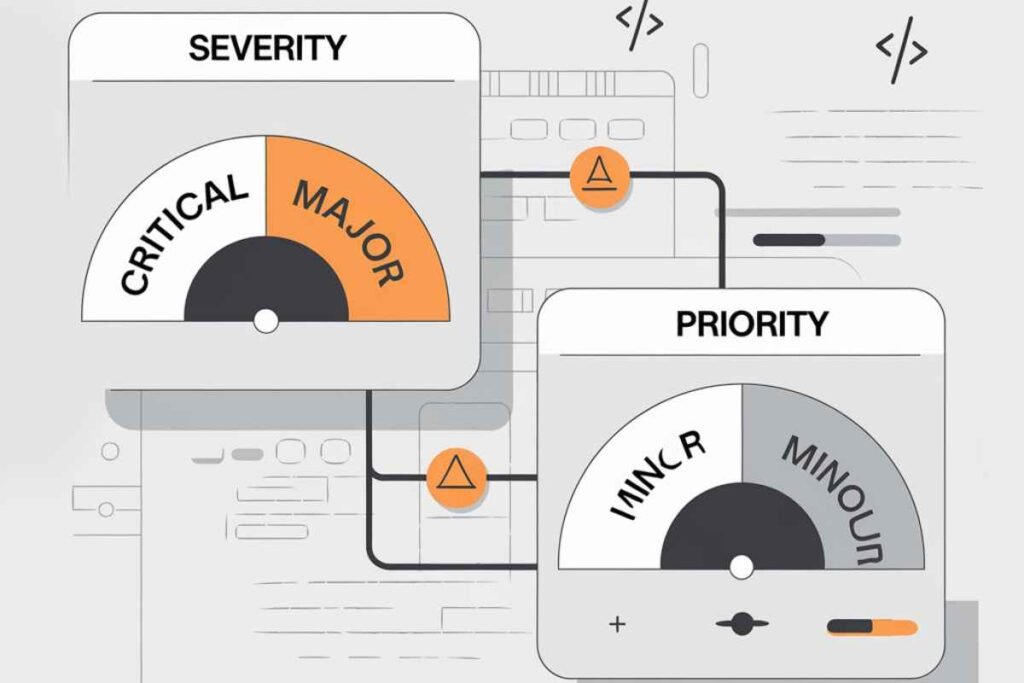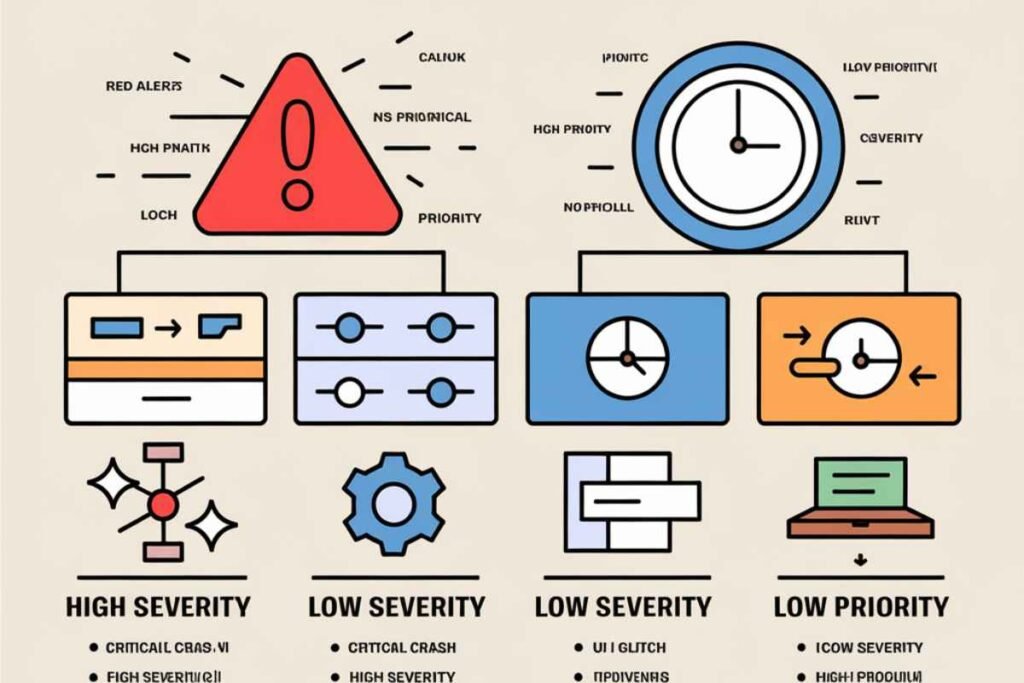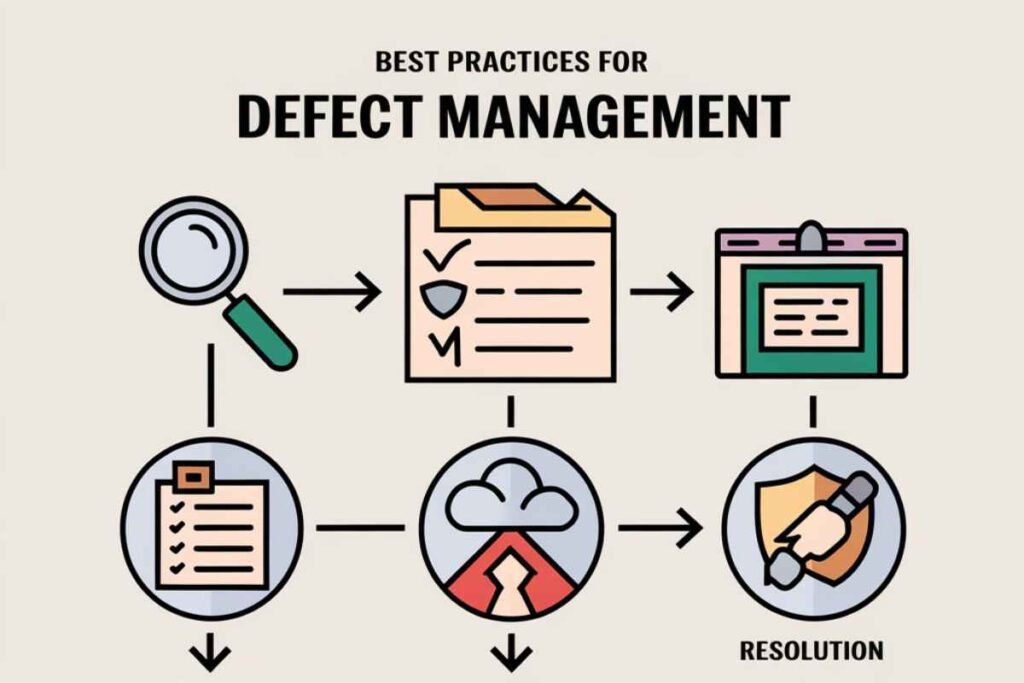In High priority and low severity example software testing, defect management is critical to ensuring a product’s quality.
One of the key concepts in defect management is distinguishing between severity and priority. These two factors help determine how defects should be handled in different stages of the project.
This article will specifically explore the high priority and low severity example, explain its significance, and how to manage such defects in real-world scenarios.
What is Severity and Priority?

Defining Severity
Severity refers to the impact a defect has on the system. A high-severity defect usually prevents the system from functioning as expected, while a low-severity defect has a minimal effect on functionality.
Defining Priority
Priority, on the other hand, determines the urgency with which a defect should be fixed. A high-priority defect requires immediate attention, while a low-priority defect can be addressed later.
Relationship Between Severity and Priority
While severity focuses on the impact of a defect, priority addresses its urgency. These two factors do not always correlate, which is why it’s important to differentiate between them when managing defects.
Types of Severity and Priority

There are 4 types of Severity and Priority :
High Severity and High Priority
A high severity and high priority defect can cause critical system failures and must be resolved immediately to prevent delays or larger issues.
High Priority and Low Severity Example
A high priority and low severity example may not have a significant impact on functionality but needs quick resolution due to business or project requirements.
An example of this would be a minor UI issue on the checkout page of an e-commerce website. While it doesn’t break the functionality, it might affect the customer experience, leading to the need for an urgent fix.
High priority and low severity example
These defects are severe but do not require immediate fixing. High priority and low severity example would be a critical issue in a rarely used feature of the software.
Although the defect is severe, it’s not prioritized because it doesn’t impact key functionalities or the user experience significantly.
Low Priority and Low Severity
These defects have a minimal impact and can be fixed at a later stage, without causing immediate concerns.
Impact of Defects on Projects
Understanding defects’ severity and priority is crucial for project success. While a high priority and low severity example might not affect the system’s core functionality, ignoring it can affect the user experience and potentially lead to business losses. Managing defects properly helps prevent unnecessary delays and optimizes resource allocation.
Real-World Examples and Case Studies
E-commerce Website: A slight misalignment of buttons on a checkout page may not prevent customers from purchasing, but it can reduce user confidence. Hence, it’s a high priority for developers, even if it’s a low severity issue.
Corporate Email System: A minor formatting error in the signature of outgoing emails could be classified as low severity but high priority because it could affect the company’s image.
Mobile Gaming Application: A bug that causes the background music to be muted when a player enters a specific area would be a high priority for fixing, even though it doesn’t break the game’s functionality.
Best Practices for Defect Management

Customizing Frameworks and Decision Matrices
Creating a customized decision matrix helps development teams prioritize defects based on severity and priority. This ensures that critical issues are resolved first, while lower-priority issues are addressed as resources allow.
Using Tools like JIRA for Severity and Priority
Platforms like JIRA can help teams manage defects by allowing customization of severity and priority fields. This ensures that each defect is assigned a priority and severity level based on its impact and urgency.
With JIRA, teams can streamline defect resolution by tracking issues effectively and adjusting priorities as needed, making it easier to manage and resolve defects in a timely manner.
This customization also supports better communication across teams, ensuring everyone is aligned on defect resolution strategies.
Best Practices for Agile and Resource Allocation
In Agile environments, defects need to be addressed quickly to maintain the pace of development. Regular backlog grooming helps prioritize high priority and low severity defects effectively, ensuring they don’t disrupt the overall progress.
Conclusion
Understanding and fixing high priority and low severity defects is crucial for delivering quality software. While these issues may seem minor, they can negatively impact a product’s appearance, user experience, and brand image.
Small defects like a typo or a broken link may frustrate users, leading to a loss of trust. By quickly addressing these issues, businesses can maintain a professional and reliable image, which helps keep customers happy and loyal.
Taking care of these small problems ensures a better product overall and helps teams meet their goals on time, improving both user satisfaction and business success.
FAQs
What is a High Priority and Low Severity Example?
A high priority and low severity example refers to a defect that is not critical but requires immediate attention due to its potential impact on user experience or business objectives.
How Can You Manage High Priority and Low Severity Defects?
By assessing the urgency and impact, development teams can address these defects quickly while ensuring they don’t interfere with more critical tasks.
Why Are High Priority and Low Severity Defects Important?
These defects may not break the system but can still negatively affect the user experience, making it important to address them promptly.
Can High Priority and Low Severity Defects Be Ignored?
While they may seem trivial, ignoring them can harm the product’s quality and the company’s reputation, especially if they affect user perception.
What Tools Can Help Manage Defects Based on Severity and Priority?
Tools like JIRA allow teams to manage and track defects based on their severity and priority, ensuring timely fixes.
How Do You Prioritize Defects in an Agile Environment?
In Agile, defects are prioritized using a decision matrix and regular backlog grooming, ensuring that critical issues are addressed first.
What Are the Risks of Not Addressing High Priority and Low Severity Defects?
Ignoring these defects can result in user dissatisfaction or delayed project timelines, potentially harming the product’s reputation.
How Do Severity and Priority Affect Resource Allocation?
Correctly identifying the severity and priority of defects helps allocate resources efficiently, ensuring critical issues are handled first while lower-priority issues are managed in due course.